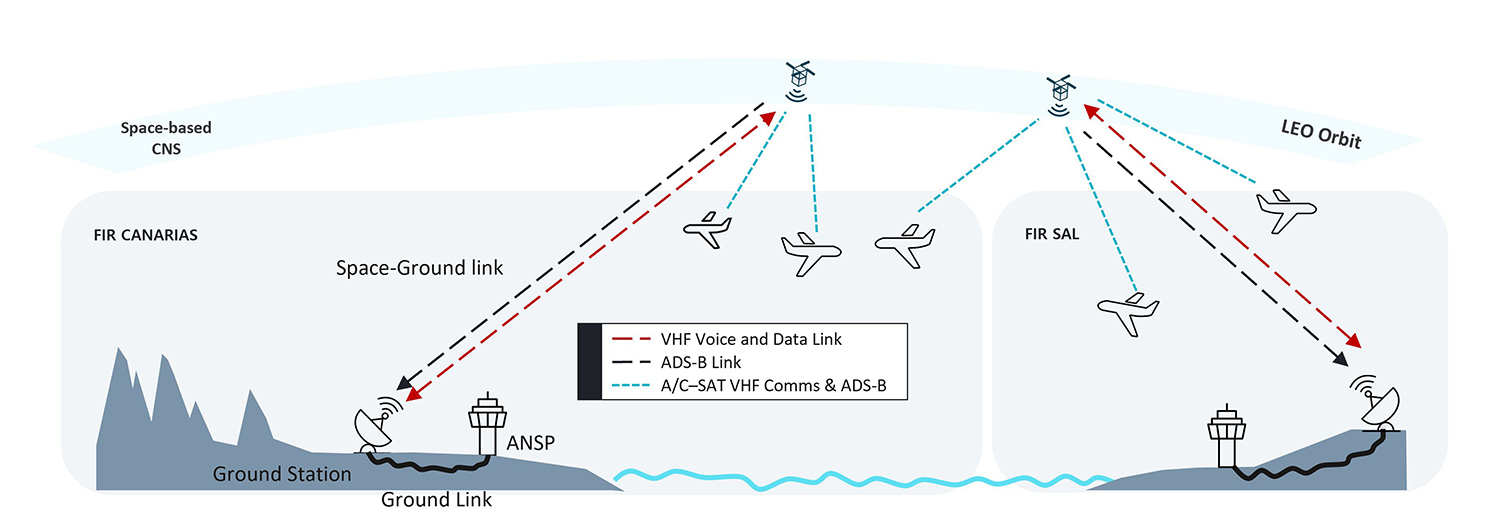Plans are underway by SESAR members and partners to demonstrate the feasibility of using low-orbit satellites to provide voice communications to manage aircraft in oceanic regions of the world. The project aims to show how space-based communications navigation and surveillance technologies can help optimise air traffic while reducing the carbon footprint and maintaining safety levels.

Aircraft flying over the ocean no longer appear on ground-based radars once they are about 350 kilometres from the coast. To monitor and stay in touch with these flights, controllers today rely on high frequency radio and data link communications, through which aircraft can also report their position. While these technologies allow controllers to maintain contact and assure safe separation, their high levels of latency mean that communications is slow and results in significant time lapses. It also means that to ensure safety, controllers must increase separation minima between the aircraft.
This is where the SESAR JU large-scale demonstration, VOICE (“Reduced separations and improved efficiency based on Vhf cOmmunICations over LEO satEllites), comes in. Over the next two years, the partners will demonstrate how air traffic management (ATM) can benefit from low earth orbit satellites – a category of satellites which is low cost and requires the lowest amount of energy for placement, while providing high bandwidth and low communication latency. Specifically they will show that by using satellite-based VHF systems, controllers can communicate with aircraft in oceanic and remote airspace at the exact same rate of frequency as with aircraft in continental airspace. In doing so, using space-based ADS-B for surveillance, controllers will be able reduce the minimum separation between aircraft, which will help to optimise traffic and reduce CO2 emissions without compromising safety.
In addition, the VOICE consortium will perform several cross-border operations between adjacent flight information region (FIR) belonging to different countries - CANARIAS FIR and SAL FIR. The aim will be to show the feasibility of controllers communicating in real time with aircraft at distances greater than 1,500 km. The planned will demonstrate that, with the use of satellite-based VHF systems providing voice and datalink ATS, traffic in oceanic and remote airspace can be handled as in a continental one, and current separation could be reduced without compromising safety. In addition, VOICE project will perform some cross-border operations between adjacent FIR belonging to different countries. Demonstration will cover operations in CANARIAS FIR and SAL FIR with ATCOs communicating in real time with aircraft at distances bigger than 1500km. Demonstration exercises will use satellite-based communications, navigation and surveillance (CNS) services to test the feasibility of the ATM data provider (ADSP) concept , in other words allowing controllers to manage traffic no matter their location and the airspace in question. The following use cases will be used in the demonstration activities:
-
Use Case 1: Use of satellite VHF for voice/data and space-based surveillance technology called automatic dependent surveillance–Broadcast (ADS–B) without terrestrial coverage;
-
Use Case 2: Use of satellite VHF for voice/data and ADS-B as a means of contingency/delegation;
-
Use Case 3: Use of satellite VHF for voice /data and ADS-B exchange in terrestrial airspace.
Funded within the framework of the Horizon 2020 research and innovation programme (grant agreement 101017688), the project brings together the following project partners: Indra (Coordinator), Enaire, EUROCONTROL, GOMSPACE A/S and GOMSPACE Luxembourg.

